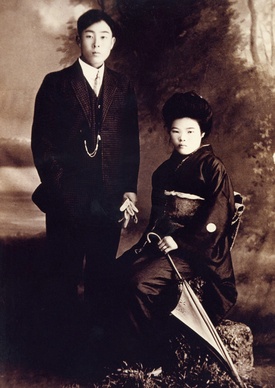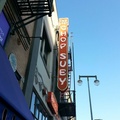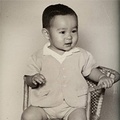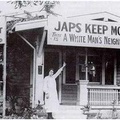“I like to be in America!
O.K. by me in America!
Everything free in America!
For a small fee in America!”
Immigration. There’s so much debate. For and against. Passion. Compassion. Fear and anger. Some calling for the inscription on the Statue of Liberty erased.
Immigrants are what made this country great.
I am a grandson of immigrants. My generation is the first in my family to ever attend and finish college.
My grandfather on my father’s side came from Hiroshima.
So did my grandmother on my mother’s side.
(My grandmother on my dad’s side was born in Fresno. My granddad on my mom’s side was born in Hawaii.)

Toyoshima Family. My grandfather Riyoichi Toyoshima and my grandmother Someno and their boys. (Circa 1924)
The Toyoshimas and the Babas came to America, like all immigrants for a better life.
It wasn’t easy. Life wasn’t much better than the old country. Perhaps worse. From humble rice farmers in Hiroshima to cutting sugar cane in the sweltering hot Hawaiian sun for pennies a day, work was nearly slave labor.
For my dad’s father, those pennies were saved so that he could raise a family in America. Eventually rent a farm. And when he believed his boys became adults and could become independent, he wanted to move back to Japan. To his childhood home that hugged the mountainside that overlooked Hiroshima valley.
That original homestead was nestled among towering pines and larch. The land just below the house was cleared and terraced for rice growing.
Thankfully, they were spared the atomic bomb that obliterated the entire valley. Though my dad’s cousins died of radiation related cancer (both of them were nurses that tended to the victims). A tip of my hat to first responders.
My grandfather’s dream of returning to Japan changed. America was his home now. I remember him saying that. “I’m no longer Japanese. I’m an American. My family is here. This is where I belong.”
And like all immigrants, he worked hard. Harder than the next guy. For little money. But he never complained.
To be a farmer meant waking up at 4 am, toiling in the fields all day until it got too dark to see. During harvest time, he would pull his cars and truck and turn the headlights on to pick the vegetables. Bedtime was sometimes 1 am in the morning. And the same cycle started at 4.
Every family member was required to work the fields. Balance that with school, homework, and Japanese language school (most Nisei kids took Japanese language classes so that they could better communicate with their issei, or first generation parents, but to also retain their culture).
My grandmother Ishi (my mom’s mom) was born in Hiroshima as well. She came to Hawaii in an arranged marriage to my granddad, George Baba. This was back in 1919. (In late June of 1918, George was drafted into the U.S. Army Infantry, but the war ended in July, and he didn’t have to fight. He did go through boot camp.)
She and George were married. Both of them cut sugar cane. They relocated to Fresno to pick fruit during the early ‘20s and ‘30s. The time of Grapes of Wrath. They worked in labor camps. Japanese Americans were often hired over “Okies” because they would work for almost nothing. And nothing was fair in those days. You worked or you starved.
George saved his money and eventually bought a farm in Southern California (since he was an American citizen, he was allowed to; alien laws prohibited foreign-born to own land.)
With Pearl Harbor, WW2, and the interment camps, the farm was lost. With only a week to pack and leave, the farm was sold for a song.
Despite that setback, after the War, George became a gardener. He bought an old Ford Model A truck (he eventually traded up to a used 1948 Chevy truck) and some lawn mowers and that became his career until he retired.
His wife Ishi worked at Starkist and Van Kamp’s hand cleaning and packing tuna into cans. She often came home with pin-bones in her fingertips. I remember my mother having to tweezer them out. I can’t imagine the pain. Standing on your feet all day, with fish bones in your fingers. The cannery was stifling hot and humid and reeked of fish. I remember the smell outside the cannery—rancid.
She eventually retired and earned a pension and collected social security.
But her greatest achievement was achieving citizenship. She, like many Isseis would eventually get their American citizenship anyway, but my grandmother studied. She brushed up on her English. She knew her American history, the Constitution, and the branches of government.
It was a proud day when all of us went to her swearing in ceremony. All of us had tears in our eyes.
When my “people” arrived in this country, we were not welcomed. From the get go, we were called “Japs” and “Yellow Devils” and told to go back where we came from.
But that didn’t deter them. It made them stronger. Even more determined to be an American.
If not for them, I wouldn’t be here. And I often wonder if I would have had the same grit as they had. I don’t know. I’ve grown soft.
I think far too many Americans have as well.
But not the immigrant. They still have that fire lit in them. They still seek “the dream.”
“Sail away.
Sail away.
We will cross
The mighty ocean
Into San Francisco Bay.”
Whether by boat, plane, or crossing the desert by foot,
“I like to be in America.”
© 2013 David Toyoshima






